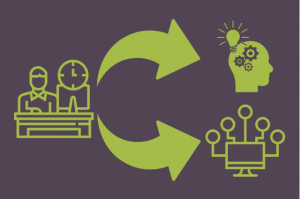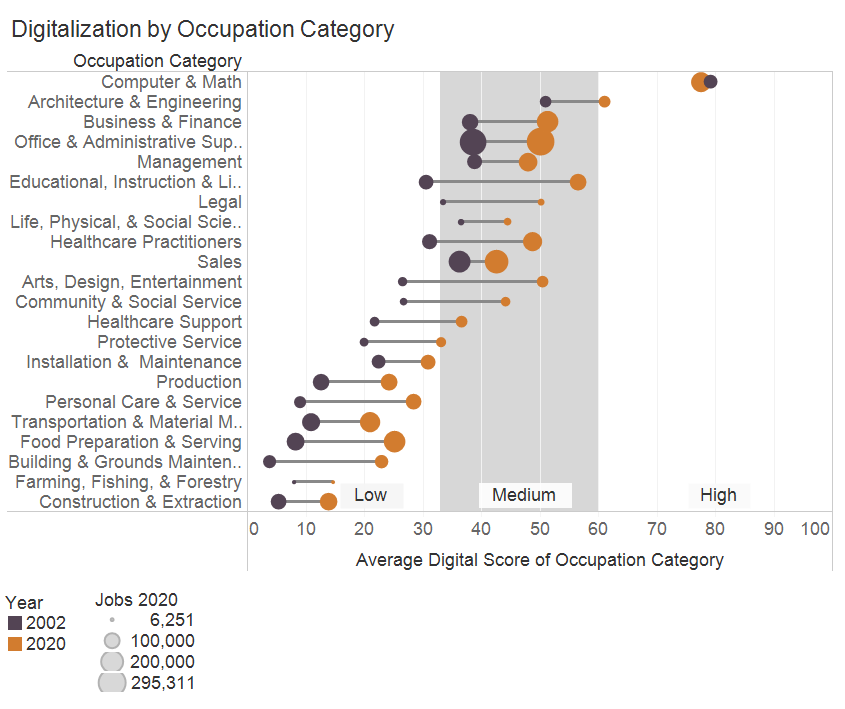Focus: Essential Employability Skills
Over the last 20 years, the use of information communication technology has increased in virtually all jobs. This digitalization of the workplace means that even the most basic work functions require some level of digital literacy. Digital literacy or digital skills are defined fairly broadly, for instance, “the ability to understand and to use information from a variety of digital sources”1 or, “a mindset that enables users to perform intuitively in digital environments, and to both easily and effectively access the wide range of knowledge embedded in such environments.”2
 The digitalization of the workforce3 along with the digital divide4 has contributed significantly to the growth in income inequality. Workers with more digital skills and more digital access have greater opportunities and, at the same time, digital access and the opportunity to develop digital skills are far from equitable. The increasing requirements for digital competencies in entry and midlevel jobs introduce another barrier to access living-wage careers for marginalized communities. The digitalization of even low-education, low-wage jobs make it essential to systemically improve digital access, targeting underserved communities, and ensure that all workers have basic digital literacy.
The digitalization of the workforce3 along with the digital divide4 has contributed significantly to the growth in income inequality. Workers with more digital skills and more digital access have greater opportunities and, at the same time, digital access and the opportunity to develop digital skills are far from equitable. The increasing requirements for digital competencies in entry and midlevel jobs introduce another barrier to access living-wage careers for marginalized communities. The digitalization of even low-education, low-wage jobs make it essential to systemically improve digital access, targeting underserved communities, and ensure that all workers have basic digital literacy.
Growth in Demand for Digital Skills
The Digital Score metric estimates the percentage of tasks in a specific job that are digital and the skill level of those tasks (basic, intermediate, or advanced), that can be categorized as low, medium, and high digital skill jobs. The average digital score (on a scale of 1-100) across all occupations in the United States rose by 57%, from 29 in 2002 to 46 in 2016. The mean digital score for the Seattle-Tacoma-Bellevue region rose from 27 in 2002 to 43 in 2016 ranking the region eighth in the top 15 metro areas by digital score in the US.3
Despite the overwhelming emphasis on learning to code, the growth in digitalization has not been driven by growth in digitally intensive jobs that demand advanced skills. Even middle digital score jobs — those involving regular digital tasks and intermediate digital skills — like company managers, finance or HR professionals, and other technical professionals have experienced a large change in their digital scores. Rather, the change is seen most starkly in occupations that are not digitally intensive. For example, the digital score of construction laborers rose from 2 in 2002 to 17 in 2016, and for welders, cutters, solderers, and brazers, it jumped from 3 to 23.

Figure 1. Digitalization4 by Occupational Category (adapted from Muro et all)3
Due to the combination of growth in occupations requiring medium and high digital skills and the increase in digital skills required for almost all occupations, in the Seattle metropolitan statistical area (MSA), the share of employment in the high digital score nearly doubled, medium digital score jobs increased from 44% to 60%, and employment share in low digital score jobs declined from 50% to 29%.
 Figure 2. Seattle MSA Jobs by Digital Skills Category4
Figure 2. Seattle MSA Jobs by Digital Skills Category4
The data shows two significant trends in the labor market. First, most of the change in demand for digital skills (over 90%) is due to an increase in the digital content of existing jobs. In other words, occupations that scored low on the digital score in 2002 did not disappear, rather they now require higher levels of digital literacy. Second, these same occupations are responsible for the vast majority of the increased demand for digital skills in the workforce. Many former low-technology jobs now require middle-level digital skills and nearly all jobs require some digital skills, even entry-level jobs most accessible to those with limited educational attainment.3
“Good jobs” or full-time jobs that pay higher than the national average and do not require a bachelor’s degree in 2016 had an average digital score of 50, up from 29 in 2002.3 This is largely due to basic productivity software knowledge of which is now required in many jobs. This software includes the all-purpose Microsoft Office Suite (Excel, Word, Outlook, PowerPoint) to more specialized software like Salesforce, SAP, and Oracle. The healthcare sector requires competency in a range of specialized software and technology for everything from vital sign measurement, medical billing and coding, to online health information management systems. The manufacturing industry uses programs like AutoCAD, Computer Numerical Control (CNC), and Computer-Aided Manufacturing (CAM).
However, while middle-skill jobs are increasingly using a wide range of specialized and advanced software, many require only fairly standard skills. A national survey of 2,700 manufacturing firms found that “62% of manufacturing firms’ core workers are required to use a computer on at least a weekly basis” but only 28% of firms require those core staff to use specialized software like CAD or CAM. 42% only require “either basic word processing or the ability to perform internet searches for information.”5
In addition, many jobs that require little to no formal training or education also require essential computer skills. For example, cashiers use computers or iPads in place of analog cash registers. In 2002, there were no jobs in Food Production & Serving, Building & Grounds Maintenance, or Personal Care & Service in the Seattle MSA that required more than low digital skills. But in 2020, there are 110,000 jobs in these sectors that require medium digital skills. In addition, the average score among those requiring low skills increased from 8 to 17 as jobs require the basic use of email, office software, and other digital tools.
Inequities in Digital Literacy
In general, the research shows that increased adoption of information technology allows for more growth and innovation, as well as increases inefficiency in the workplace. Repetitive or routine tasks are largely taken over by computers and specialized software, freeing up more time in a person’s workday for “high-order” tasks like critical thinking, being creative, and generating new ideas. It has also created new jobs that didn’t previously exist. For example, digitalization has vastly expanded jobs that involve managing and analyzing data that wasn’t previously gathered or aggregated and, of course, maintenance, management, and creation of information technology systems.
Not everyone shares in the benefits of the digitalization trend. It has exacerbated inequities rooted in access to education as those with more access and training in how to use digital tools are well-prepared for a digitalized workforce and those who lack the training and access are not. The 2018 Technology Access and Adoption Study by the City of Seattle found that, while internet access is nearing 100% in Seattle, when dividing access by income sector, only 79% and 70% of households earning less than $25,000 per year have a smartphone or computer respectively. This is compared to 90% and 92% for those same devices for households with an annual income of $25,000 to $50,000. Households with an annual income above $50,000 have access levels at 96% and higher.6

Figure 3. Technology in Seattle Homes by Income6
Paired with lower access, individuals in lower income households have fewer digital skills as measured on a digital skills index. More than one-third of those in households with incomes below $25,000 score 60 or lower while less than 3% of individuals in households with incomes $50,000 more score 60 or below.6

Figure 4. Seattle Residents’ Digital Skill Level by Household Income6
Individuals need digital access and basic digital literacy to even apply for and obtain entry-level employment. Job searches, completing job applications, and participating in web-based interviews require having access to a computer and knowing how to use it. Higher-level job search skills including building a LinkedIn profile or digital resume, leveraging online social networks to gain access to job opportunities, and demonstrating to employers the ability to learn relevant technology skills on the job.
There are programs to help individuals gain these skills. However, the 2018 Technology Access and Adoption Study by the City of Seattle found that “low-income programs are not well used or known.” Only 23% of eligible households enroll in programs to increase low income households’ access to the Internet. Of those in eligible households, 53% were not aware of the programs; 24% were aware but did not use the programs.6
Assessing Individual Digital Literacy
The data is clear: having essential digital skills increases one’s chance of entering the workforce, retaining employment, and advancing to higher-paying jobs. So how can we ensure that everyone has access to education to get those skills? Policymakers, educators, and employers must collaboratively address several obstacles:
Identify Essential Digital Skills
Can we agree on a checklist of minimum abilities that a jobseeker must-have? Unlike many “soft” skills, digital skills are measurable. They are also eminently teachable. There are many existing curricula for digital literacy, both free or paid, but there is no one standard set of basic digital literacy.
The City of Seattle has done a comparison of basic digital skills assessments and curricula.? For example, Northstar has created a free evaluation tool that assesses three gateway skills including essential computer skills, essential software skills, and using technology in daily life.7
Evaluate Credentials and Assessments
Unless employers use digital literacy assessments as a screening tool, how can job seekers show they are indeed proficient in basic computer usage or software like the MS office suite? There are multiple micro-credentials and badges that have the potential to reduce employer uncertainty. However, the number of different credentials is its own source of uncertainty. What is worthwhile and credible?
Credential Engine compiles the credentials from secondary school diplomas to licenses, including badges and microcredentials. They offer a comparison tool, indication of quality assurance, and what occupations and industries it is being used in.? This is a tool for policymakers, program designers, instructors, advisors, and employers to assess what badges and micro-credentials are worthwhile. However, it is just a tool to help these credentials gain traction and become a useful signal to employers that job seekers have the desired skills. Decision-makers still need to
incorporate it into programs and hiring criteria for their full value to be realized.
Community colleges and other traditional higher education institutions are still the main venues offering these credentials. And though badges are often earned through short-term training and thus are more accessible than degree programs that require more time and financial commitment, workers still face barriers to access. To effectively provide basic employability skills training, particularly digital literacy, these certification processes need to be made as accessible as possible, including making them accessible and no cost to participants.
Recommendations
While coding and computer programming seem like buzz words and trending topics, policymakers and educators—especially for the adult jobseeker population—need to focus on computer skills as basic as turning the computer on and off, navigating files and folders, web browsing, adding e-mail attachments, etc, along with middle skills needed to use standard office software and occupation-specific software and apps.9 These are now essential employability skills10 and are a pre-requisite to be successful at other job-related skills. In order to do this, we make the following
recommendations:
- Integrate available digital literacy assessments or curricula into training programs and establish a regional standard for basic computer competency, a metric for assessment, and a certification that is recognized and accepted. The City of Seattle’s work provides a strong starting point for this effort.5
- Invest in and promote the awarding of quality micro-credentials that document critical skills in education and training programs throughout the city, including through city-supported on-ramp programs, and partnerships with community colleges, K-12 Career and Technical Education (CTE) programs, and business/industry. This will drive efficiencies by reducing repetitive training and help employers identify new workers ready to learn and use technology on the job.
- Improve equitable access to quality micro-credentials by lowering financial barriers to enrollment, such as through government or employer-sponsored tuition subsidies. Promote opportunities to earn micro-credentials to historically underserved communities and support the design and delivery of microcredentials that are accessible to residents with low digital literacy, English Language Learners, first-generation postsecondary students, and others with barriers.
- Ensure graduates from our K-12 system possess critical digital literacy competencies and are prepared to learn advanced skills in the community and technical college system, apprenticeships, or other postsecondary pathways. It is insufficient to assume that K-12 students acquire these critical skills through self-directed learning. Exposure and widely available technology does not ensure readiness to engage in the digitalized workforce and post-secondary learning.
- Incorporate information and support for accessing the City of Seattle’s programs supporting digital access for Seattle residents in on-ramp programs and other service programs.11 Develop similar programs to serve the broader King County community.
Addressing digital literacy gaps and connecting communities to economic opportunity requires a systemic effort across the workforce ecosystem. Together we can prepare our communities workforce for the job opportunities of today, and to learn the skills needed for the future economy.
1. Glister P. Digital literacy. Wiley Computer Pub. New York; 1997.
2. Martin A. Digital literacy and the “digital society.” Digit Literacies Concepts Policies Pract. 2008;30:151-176.
3. Muro M, Liu, Whiton J, Kulkarni S. Digitalization and the American workforce. 2017. https://www.brookings.edu/wp-content/uploads/2017/11/mpp_2017nov15_digitalization_full_report.pdf. Accessed September 11, 2019.
4. Jimenez, Y. A digital divide builds a steeper wall of inequality. Center for Law and Social Policy (CLASP). https://www.clasp.org/blog/digitaldivide-builds-steeper-wall-inequality
5. Weaver A, Osterman P. Skill demands and mismatch in U.S. manufacturing. ILR Rev. 2017;70(2):275-307. doi:10.1177/0019793916660067
6. Wedlake S, Keyes D. Seattle digital equity initiative digital skill sets for diverse users. A comparison framework for curriculum and competencies. :20.
7. Northstar Digital Literacy Assessment. https://www.digitalliteracyassessment.org/. Accessed February 27, 2020.
8. Credential Engine. https://credentialengine.org/. Accessed February 2, 2020.
9. Digital skills toolkit. Skills for employment: knowledge sharing platform. http://www.skillsforemployment.org/KSP/en/Details/?dn=EDMSP1_212624. Accessed December 20, 2019.
10. Employability skills: future of work, part III. Seattle, WA: Seattle Jobs Initiative https://www.seattlejobsinitiative.com/policy-and-research/labor-market-research/labor-market-economy/. Accessed February 27, 2020.
11. Free and discounted devices. City of Seattle Information Technology. http://www.seattle.gov/tech/services/free-and-discounted-devices. Published 2020. Accessed February 27, 2020.

Recent Comments